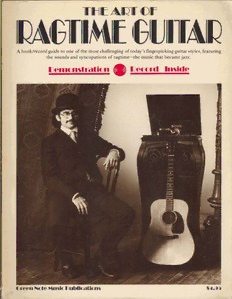
The Art of Ragtime Guitar PDF
Preview The Art of Ragtime Guitar
.-;tirecord guide to one of the most challenging of today's fingerpicking guitar styles, featllri& 6' the sounds and syncopations of ragtime-the music that became jazz. 6 i, ,< Demanstratian Recard Inside @? b .%,a' I. '.. ; L 4 r *, cations .-. - "It is the music of the hustler, of the feverishly active speculator; of the sky-scraper and the grain- elevator." -The Thunderer, March 191 3 "Ragtime and other dances come from the under- world in New Orleans." -The Literary Digest, August 1917 "Since ragtime, people are much more given to ex- citement and drink ..." -Francis Toye The English Review, 1913 "Ragtime is poison." -Carl Muck, svmphonv conductor The Literary Digest, January 191 6 "Ragtime was an important event in American cul- ture, its best performers were serious popular ar- tists ...pr operly performed it is still a wonderful music." -Martin Williams down beat, November 1971 "America's one distinct contribution to music is ragtime ..." -Carl Van Vechten Current Opinion, November 1917 w "Ragtime. A style of American popular music which originated at the end of the 19th century, one of the earliest known examples being the "Har- lem Rag" of 1895. It probably derived from the early minstrel show tunes of the 1840's and from marches, especially those improvised for street par- ades in New Orleans. .. It reached its peak about 1910-1915, afterwards merging into jazz." -Harvard Brief Dictionary of Music This manual was designed to be of use to guitarists at all levels of proficiency. Although the material is thoroughly professional-both in terms of musicality and in challenges to technique-yet for the beginner, the accompanying dem- onstration record, the clear and easy notational system, and the wealth of detailed instructional analysis, make it possible for him at the very outset to take serious steps toward creating a professional solo sound. Although the sophisticated and syncopated musical style known as ragtime, has been around, in one form or another, for something like a hundred years, it is only quite recently that guitar players have begun adding ragtime pieces to their repertoires to any great extent. Originally written to be performed by pianists and bands, the typical rag does not reduce easily to the physical requirements of the guitar; and it may have been for this reason alone that guitar players-with rare exception-long avoided the style. In any case (and notwithstanding the work of such contemporary guitarists as Rev. Gary Davis and Doc Watson), it was the guitar explosion of about a dozen years ago that actually gave impetus to the ragtime guitar movement. For never before, at one time, had so many young guitarists suddenly become available to explore the labyrinthine possibilities of the instrument. "Folkies," in quantities hitherto un- dreamed of, picked and fretted their way through the standard library of fingerstyle mater- ial, and many of them, having acquired new technical abilities which far exceeded the rela- tively simple demands of such old standbys as "Freight Train," and "Railroad Bill," began to look elsewhere for musical challenge. It was natural that ragtime, with its off-beat rhythms and jazz-like harmonic complexity, should have attracted these new pioneers of the guitar. And natural that their efforts should have resulted in what has today become a steadily-growing body of recorded work that is gaining wider and wider appreciation among a general audience. So much for a capsule history of ragtime guitar. As far as the guitarist is concerned, ragtime technique is tricky and demanding-perhaps as demanding, ultimately, as that of the clas- sical guitar. This book is the first to present the interested student/guitarist with an organized approach to the ragtime style and to attempt a codification of the style's many techniques. Thus, in the Index of Ragtime Guitar Techniques (found on p. 78), such newly-coined words and phrases as "Overfretting," and "Guide Strings," are attempts to describe and explain guitar techniques never before treated in print. The inclusion, with the book, of a demonstration record which augments and clarifies discussions in the text, is also a first in the ragtime field. It is hoped that this book will prove useful not only to those guitarishinterested solely in the ragtime style, but also to those interested in tracing back the roots of jazz, and those who are merely fascinated by the seemingly endless varieties of technique possible on that most adaptable of musical instruments, the guitar.
